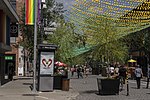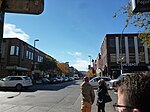Maison Radio-Canada

Maison Radio-Canada (English: CBC House) is the broadcast headquarters, studios and master control for all French-language radio and television services of the Canadian Broadcasting Corporation (known in French as Société Radio-Canada/SRC) including its flagship station CBFT-DT. It is also the main studio for Montreal's local English-language CBC services (CBMT-DT, CBME-FM, and CBM-FM) and the headquarters of Radio Canada International, the CBC's digital international broadcasting service. The street address of Maison Radio-Canada is 1400 René Lévesque Boulevard East, named for former premier René Lévesque who was once a reporter and commentator for the CBC. The building is situated near the studios of CTV (CFCF-DT), Noovo (CFJP-DT), RDS, RDS Info, MétéoMédia, LCN, and TVA (CFTM-DT) which are at the intersection of Papineau Avenue. The analogous facility for CBC's English-language networks is the Canadian Broadcasting Centre in Toronto. CBC's corporate headquarters for both languages are in Ottawa at the CBC Ottawa Broadcast Centre.
Excerpt from the Wikipedia article Maison Radio-Canada (License: CC BY-SA 3.0, Authors, Images).Maison Radio-Canada
Rue Plessis, Montreal Ville-Marie
Geographical coordinates (GPS) Address External links Nearby Places Show on map
Geographical coordinates (GPS)
| Latitude | Longitude |
|---|---|
| N 45.517981 ° | E -73.551021 ° |
Address
Maison de Radio-Canada
Rue Plessis 1400
H2L 2J1 Montreal, Ville-Marie
Quebec, Canada
Open on Google Maps










